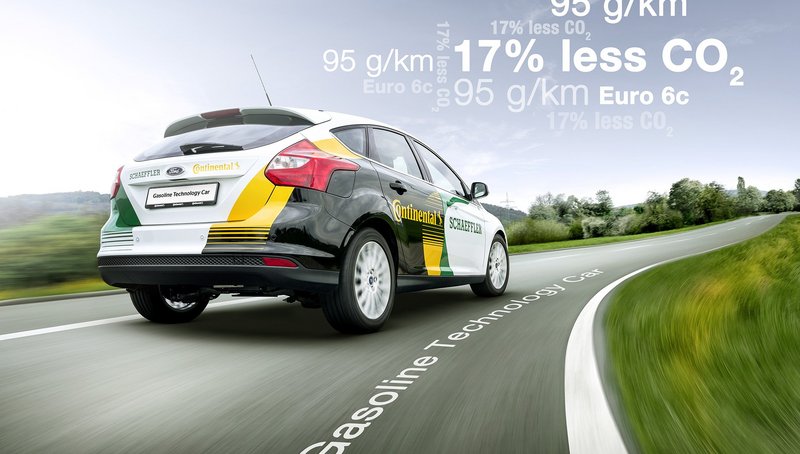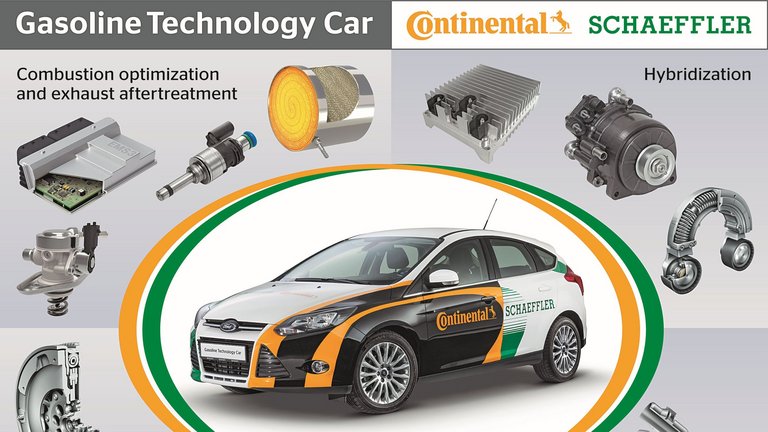Continental and Schaeffler Present Innovative Mild Hybrid
- Continental and Schaeffler presenting the joint "Gasoline Technology Car" (GTC) prototype in Vienna.
- Latest findings indicate that the key mild hybridization technologies currently available interact in the GTC to cut fuel consumption by up to 17 percent compared with efficient reference vehicle
- Networked integration of technologies has "1 + 1 = 3" effect with tangible driving benefits
Regensburg, Herzogenaurach, Vienna, May 8, 2014. The two leading international automotive suppliers Continental and Schaeffler are taking advantage of the 35th International Vienna Motor Symposium (May 8 to 9, 2014) to present the Gasoline Technology Car (GTC). The joint GTC project demonstrates how a networked integration of key mild hybrid technologies can cut fuel consumption as well as CO2 emissions by an additional 17 percent in the case of an already highly efficient car with downsized 3-cylinder gasoline engine – the Ford Focus 1.0 l EcoBoost.
"To achieve this level of hybridization, we have integrated and systematically networked key technologies from the Continental and Schaeffler portfolios into the GTC. The results we achieve with the vehicle point up the potential of this strategy in a car whose engine was nominated "International Engine of the Year 2012 and 2013” for its efficiency and performance," says José Avila, Member of the Executive Board of Continental and President of the Powertrain Division.
Prof. Peter Gutzmer, responsible on the Schaeffler Executive Board for Research and Development, explains what sets the engine apart: "Thanks to the interaction between components and technologies in the GTC, we can leverage effects to offer the motorist tangible on-road advantages in terms of fuel consumption and driveability." The automotive suppliers stress that with the integrative GTC approach, the whole is more than the sum of its parts. The formula 1 + 1 = 3 sums up this effect.
Main elements of the integrative approach
The project partners optimized every aspect of the GTC’s powertrain engineering: Appropriately adapted Continental injection and engine control units replace the system in the reference vehicle. Numerous innovative components and technologies were also added. Playing key roles are Continental’s 48 Volt Eco Drive System as mild hybridization and Schaeffler’s electronic clutch (e-clutch) for power transmission and its thermal management module. These are complemented by measures to reduce friction loss in the engine and an electrically heatable catalytic converter (Emitec). With these components and the intelligent operating strategy, the GTC prototype not only increases fuel efficiency by 17 percent overall, but it also meets the limits set by the upcoming Euro 6c emissions standard (2017/2018).
To ensure the driveability of the 3-cylinder, 1.0-liter engine despite the modified, rigorously ignition-timing-optimized operating strategy and to allow for use of additional hybrid driving strategies, the GTC features an independent second drive unit, the 48 V Eco Drive System. This includes as well an electric motor with integrated decoupling tensioner. The electric traction motor/generator is connected via a modified belt drive to the combustion engine. A DC/DC converter facilitates electrical energy flows between the 12 V voltage levels and the 48 V end with lithium-ion battery (dual-battery design). This hybridization supports the combustion engine electrically in the lower RPM range (e-boost function) to ensure attractive responsiveness without turbo lag. The highly efficient 48 V recuperation provides the basis for this. In the NEDC, the GTC can recuperate almost twice as much momentum as the vehicle requires for the vehicle electrics.
In line with the strict design-to-cost approach in force here, the GTC prototype is equipped with a conventional 6-gear manual transmission. Energy-saving functions such as coasting are also part of its drive strategy. The Schaeffler electronic clutch integrated into the vehicle makes this possible. It decouples the engine from the drivetrain when the vehicle is coasting. Therefore the combustion engine does not decelerate the vehicle and thus more kinetic energy is available for recuperation.
This energy, in turn, facilitates other efficiency-enhancing measures. One example is the electrically heatable catalytic converter. It uses the recuperation energy from the previous drive cycle to attain a working temperature faster in cold starts.
Moreover, a Schaeffler split cooling architecture with rotary slide valve facilitates graduated thermal management in the GTC. Its purpose is to master the challenges posed by innovative hybrid drive strategies. The engine can be temporarily decoupled from the coolant cycle in order to attain the required temperature more quickly or to retain its temperature longer. The rapid heat-up reduces engine friction losses. This ups efficiency, a goal likewise pursued with friction-optimized components. As part of a forward-looking operating strategy cooling can also be switched off in time for an anticipated recuperation phase (downhill stretch):
The standard Continental engine control unit used in the GTC is designed to also relieve the combustion engine of the complex job of controlling the mild hybrid components, including the operating strategy. This engine control unit gets a head start on the upcoming EMS 3 strategy. Its open AUTOSAR-based system architecture flexibly supports various partitioning schemes and electronic topologies in conjunction with hybridization and electrification.
With manual transmission, top vehicle efficiency is achieved when the driver, the optimized individual components, and the vehicle functions are in sync. For this reason, the engine control unit makes downspeeding-oriented switch point recommendations. The additional electric driving torque allows the driver to use these switch points without any negative impact on drivability and to actually achieve genuine better fuel economy on the road.

Simone Geldhäuser
Head of Media Relations, Spokesperson Finance, Business and Technology
Vitesco Technologies

